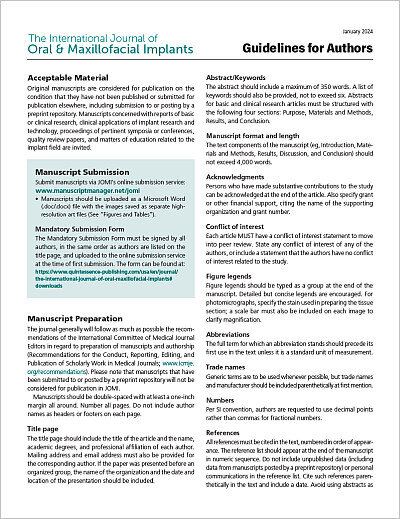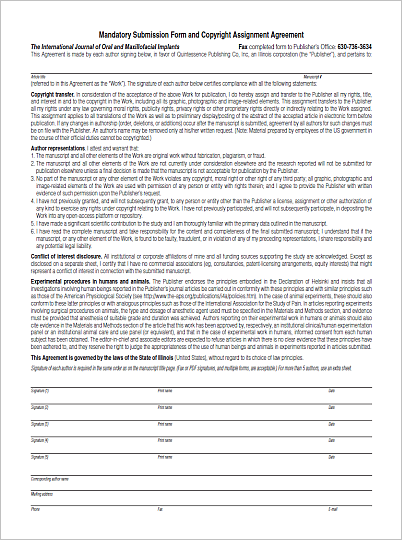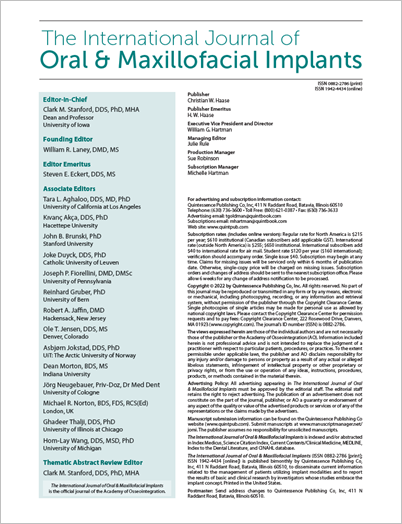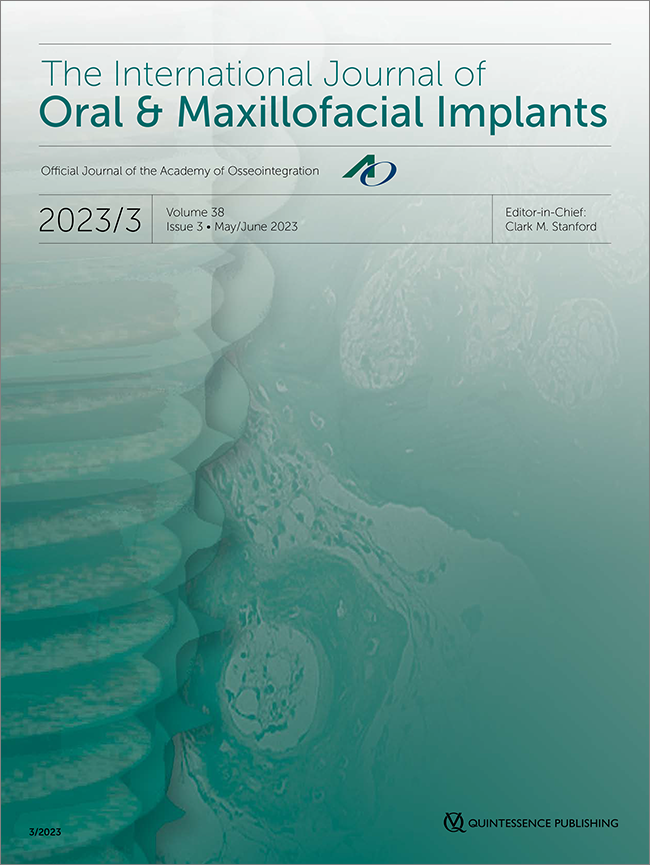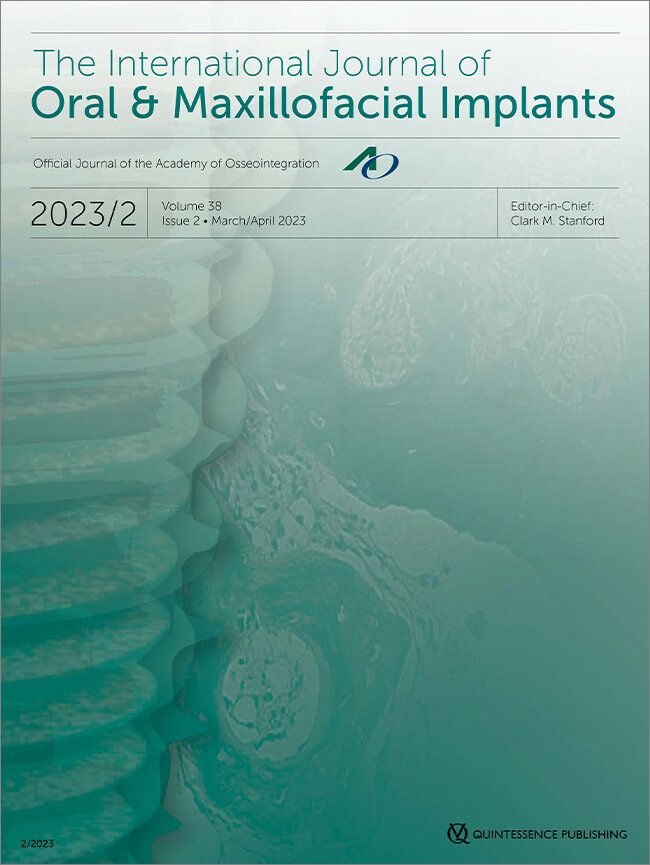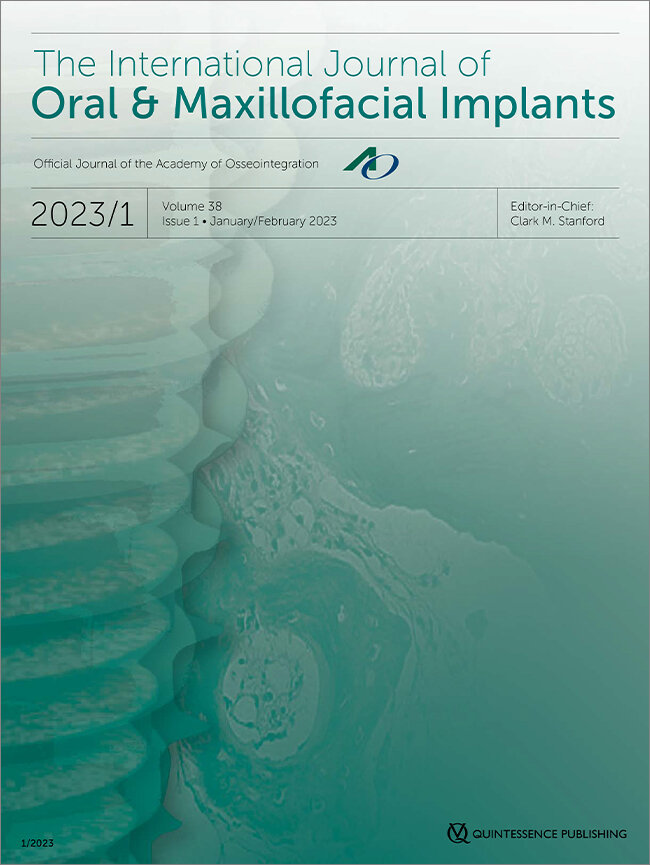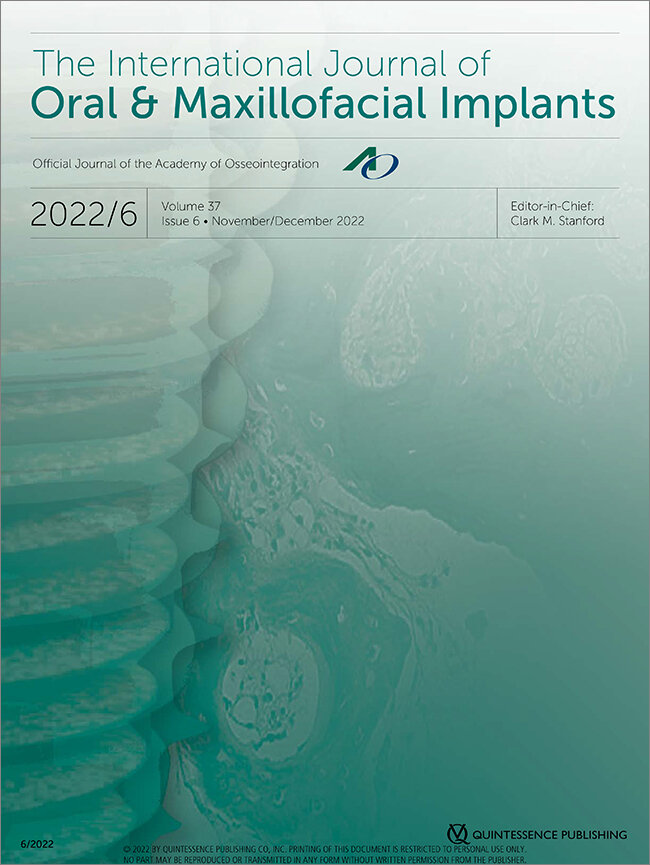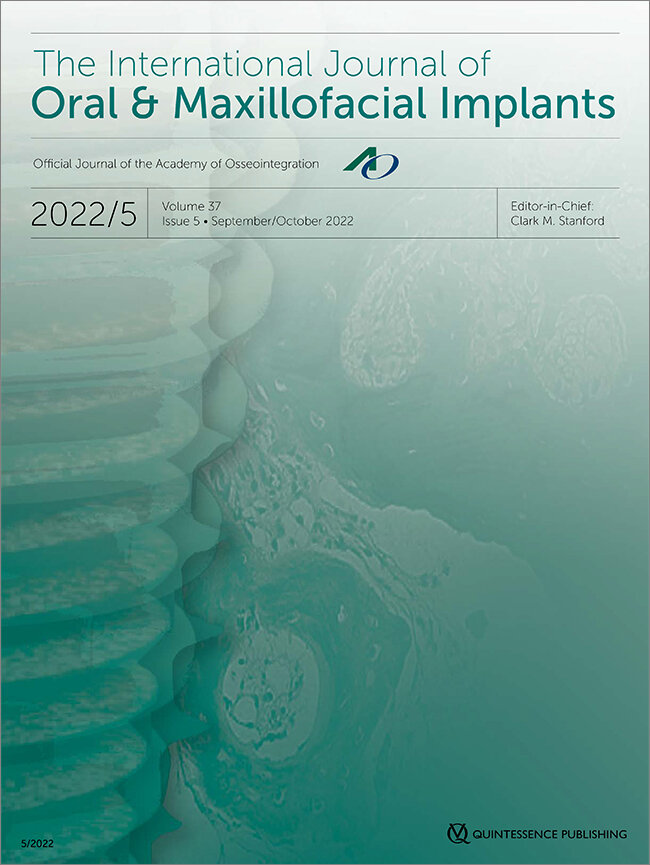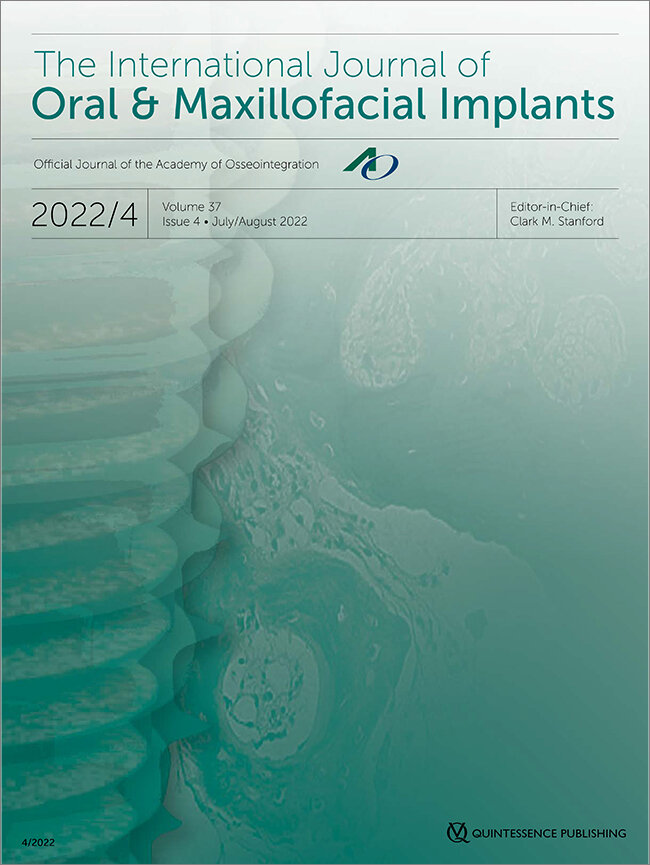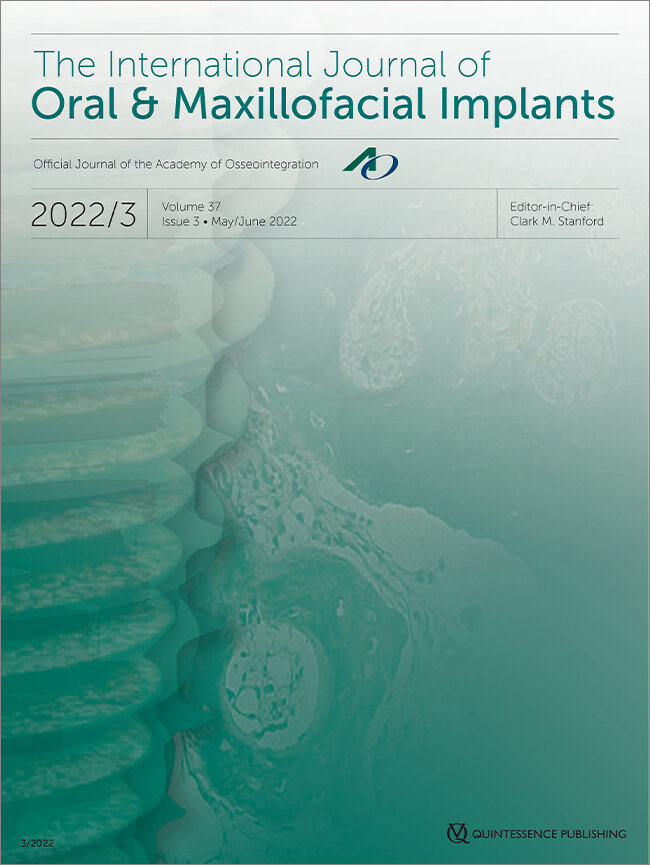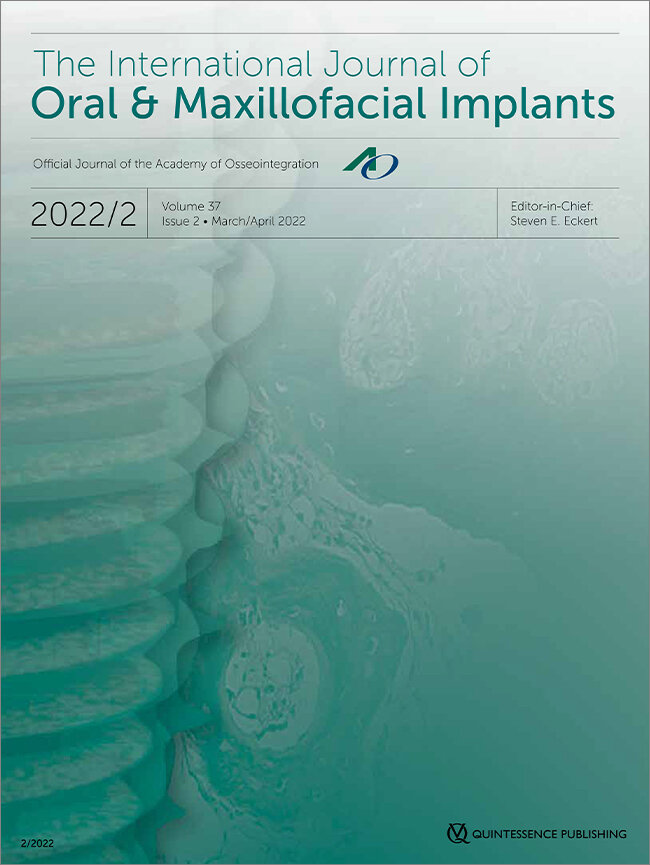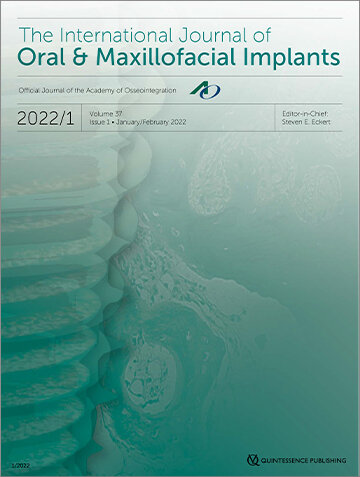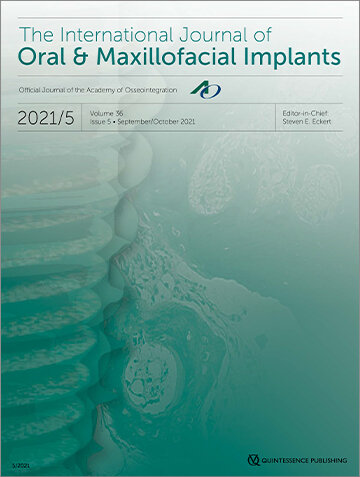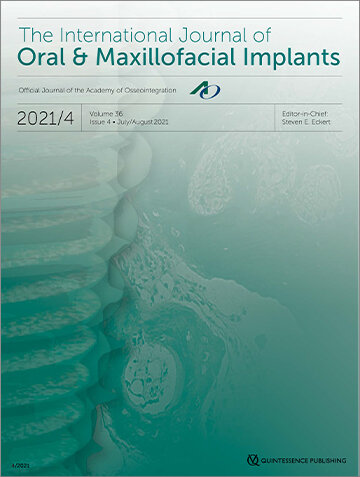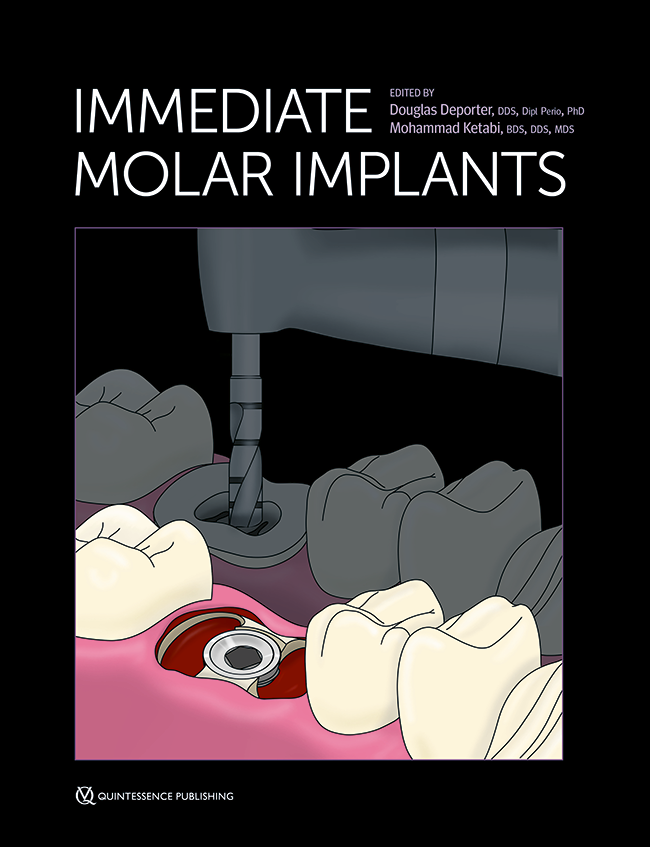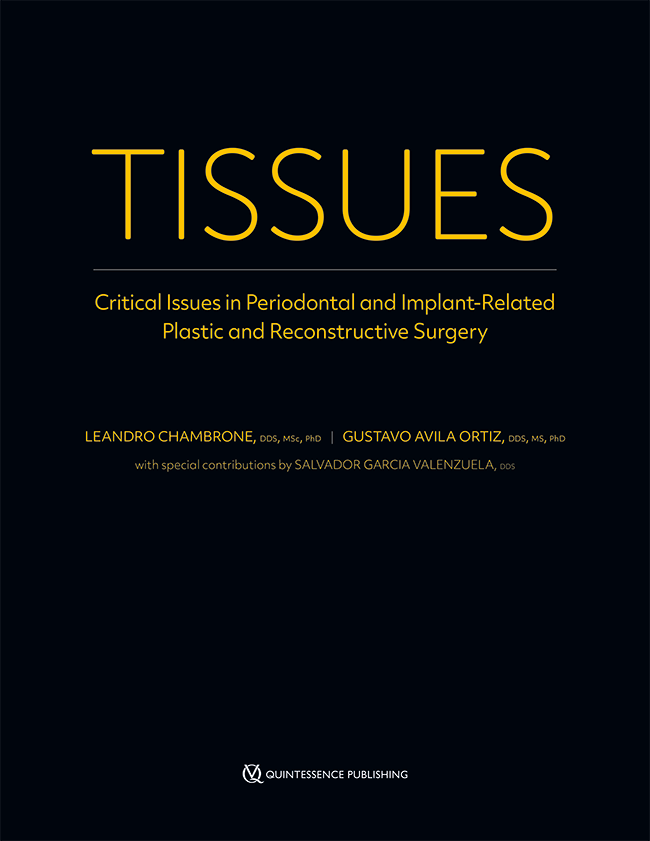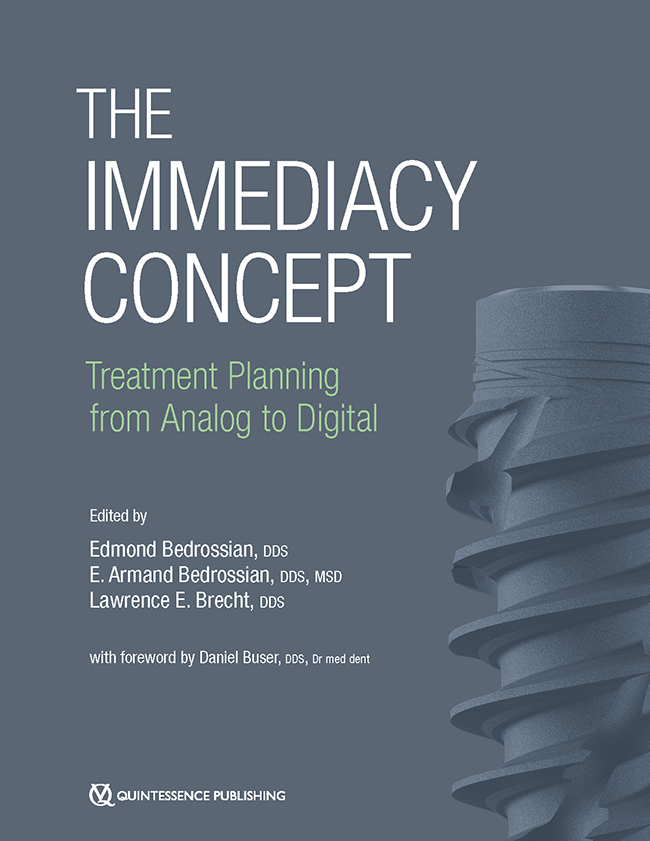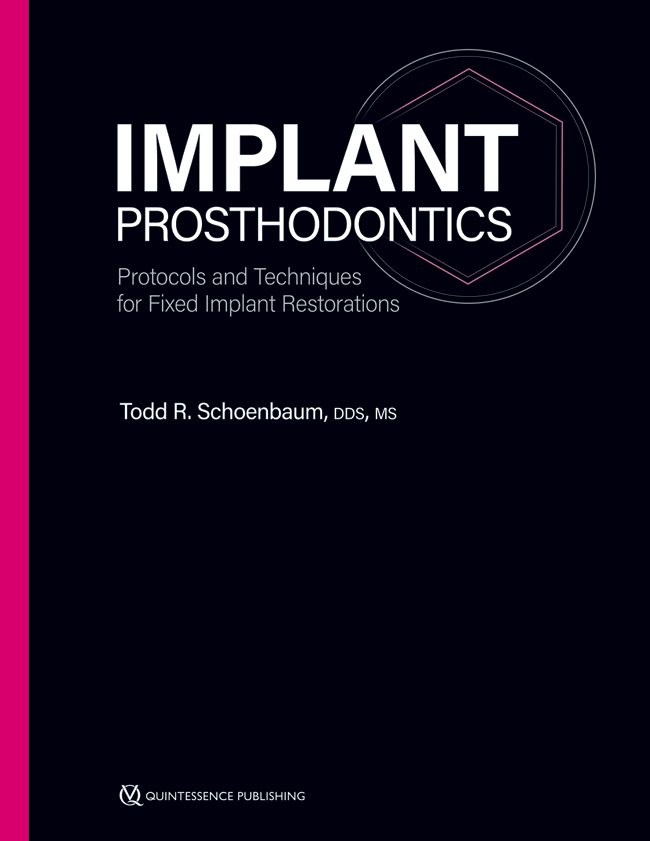Páginas 415, Idioma: InglésHartman, WilliamDOI: 10.11607/jomi.2023.3.ePáginas 408-409, Idioma: InglésStanford, ClarkEditorialDOI: 10.11607/jomi.2023.3.tarPáginas 410-414, Idioma: InglésOates, Thomas W. / Ellingsen, Jan-Eirik / Estafanous, Emad / Osswald, Martin / Chvartszaid, DavidDOI: 10.11607/jomi.10285, ID de PubMed (PMID): 37279223Páginas 417-421, Idioma: InglésSorensen, Eldon / Pendleton, Chandler / Xie, Xian JinIn dental research, it is particularly common for studies to collect data that are fundamentally correlated. Some common dental situations in which correlation arises include patients being observed across multiple teeth and/or across multiple time points, such as before and after treatment, or groups of patients being clustered (ie, familial units). For a number of traditional statistical tests and modeling techniques, the assumption of independence between observations is imperative in order to receive valid results and make accurate conclusions. This article describes how ignoring inherent correlations in data can lead to erroneous results when using traditional methods as well as the types of modeling techniques that are available to handle correlated data. Furthermore, two simulation studies are performed to further illustrate and prove the advantages of adequately handling correlated data in statistical analyses.
Palabras clave: correlation, simulation study, statistical methods
DOI: 10.11607/jomi.10112, ID de PubMed (PMID): 37279220Páginas 422-434c, Idioma: InglésQin, Rao / Chen, Yue / Han, Chong / Wu, Dongchao / Yu, Feiyan / He, DongningPurpose: To determine whether immediate implant placement and loading renders different outcomes from delayed loading with respect to midfacial mucosal level in the maxillary esthetic area.
Materials and Methods: A literature search was conducted in four electronic databases (PubMed, Web of Science, Embase, and Cochrane), identifying eligible clinical studies published prior to December 2021. Only randomized controlled trials (RCTs) comparing immediate implant placement with or without immediate loading in the maxillary esthetic zone with a mean follow-up of at least 12 months were selected for qualitative analysis and meta-analysis. The Cochrane Risk of Bias tool was adopted to assess the quality of the evidence. The heterogeneity between the pooled literature was analyzed through the chi-square test (P < .05) and quantified by the I2 index. A mixed-effects model was applied if it appeared that there was noteworthy heterogeneity; otherwise, a random-effects model was chosen. For continuous outcomes, the estimate of relative effect was presented to display the standardized mean differences (SMDs) and 95% CIs. For dichotomous variables, the Mantel-Haenszel statistical method was applied with effect sizes expressed as risk ratios (RRs) and 95% CIs. This study is registered on PROSPERO with number CRD42017078611.
Results: Out of 5,553 records, 8 RCTs were involved, providing data for 324 immediately placed implants (immediate implants subjected to immediate loading [IPIL]: 163; immediate implants subjected to delayed loading [IPDL]: 161) that had been in function within 12 to 60 months. Meta-analyses revealed significantly lower midfacial mucosal level changes for IPIL compared with IPDL, pointing to 0.48 mm (95% CI: –0.84 to –0.12; P = .01), as well as more significant papillary recession after IPDL (SMD –0.16; 95% CI: –0.31 to 0.00; P = .04). The differences regarding implant survival and marginal bone loss between the two loading groups showed no statistical significance. The result of metaanalyses revealed similar plaque score (SMD 0.03; 95% CI: –0.22 to 0.29; P = .79) and probing depth (SMD –0.09; 95% CI: –0.23 to 0.05; P = .21) for IPIL and IPDL. On the other hand, IPIL induced a trend toward more bleeding on probing (SMD 0.22; 95% CI: 0.01 to 0.42; P = .04) and less change in facial ridge dimension (SMD 0.94; 95% CI: –1.49 to –0.39; P < .01).
Conclusion: After a follow-up ranging from 12 to 60 months, midfacial mucosa level change was 0.48 mm lower following IPIL compared with IPDL. Immediate implant placement and loading is conducive to the preservation of physiologic soft and hard tissue architecture, appearing to offer considerable benefits in the anterior zone. In summary, IPIL should be considered in the esthetic zone if the primary implant stability permits.
Palabras clave: dental implants, esthetics, immediate dental implant loading, single-tooth
DOI: 10.11607/jomi.10053, ID de PubMed (PMID): 37279228Páginas 435-442a, Idioma: InglésYi, Yuseung / Heo, Seong-Joo / Koak, Jai-Young / Kim, Seong-Kyun / Koo, Ki-TaePurpose: To analyze the biologic and mechanical complications of splinted and nonsplinted implant restorations.
Materials and Methods: A total of 423 patients (n = implants: 888) were included in the study. Biologic and mechanical complications that occurred for 15 years were analyzed using the multivariable Cox regression model, and the significant effect of the splinting of prostheses and other risk factors were evaluated.
Results: Biologic complications occurred in 38.7% of implants: 26.4% of nonsplinted implants (NS) and 45.4% of splinted implants (SP). Mechanical complications occurred in 49.2% of implants: 59.3% NS and 43.9% SP. Implants splinted with both mesial and distal adjacent implants (SP-mid) had the highest risk of peri-implant diseases. As the number of implants splinted increased, the risk of mechanical complications decreased. Long crown lengths increased the risk of both biologic and mechanical complications.
Conclusion: Splinted implants had a higher risk of biologic complications and lower risk of mechanical complications. The implant splinted to both adjacent implants (SP-mid) had the highest risk of biologic complications. The greater the number of implants splinted, the lower the risk of mechanical complications. Long crown lengths increased the risk of both biologic and mechanical complications.
Palabras clave: component fracture, mechanical complication, peri-implant disease, peri-implantitis, splinting
DOI: 10.11607/jomi.10054, ID de PubMed (PMID): 37279229Páginas 443-450b, Idioma: InglésYi, Yuseung / Heo, Seong-Joo / Koak, Jai-Young / Kim, Seong-Kyun / Koo, Ki-TaePurpose: To analyze the success and survival of splinted and nonsplinted implants.
Materials and Methods: A total of 423 patients (n = implants: 888) were included in the study. The success and survival of implants for 15 years were analyzed using a multivariable Cox regression model, and the significant effect of the splinting of prostheses and other risk factors were evaluated.
Results: The cumulative success rate was 34.2%: 33.2% in nonsplinted (NS) and 34.8% in splinted implants (SP). The cumulative survival rate was 92.9% (94.1%, NS; 92.3%, SP). Whether to splint was not related to the success and survival of implants. The smaller the implant diameter, the lower the survival rate. The crown length and implant length were significantly associated only with NS implants: The longer the crown length and the shorter the implant length, the greater the risk of implant failure. The emergence angle (EA) and the emergence profile (EP) had a significant effect on only the SP implants: EA3 showed a higher risk than EA1, and EP2 and EP3 had a higher risk of implant failure.
Conclusion: Crown length and implant length affected only the nonsplinted implants: The higher the crown length and the shorter the implant length, the greater the risk of implant failure. A significant effect for emergence contour was found only in SP implants: the implants restored with prostheses with EA ≥ 30 degrees on both the mesial and distal sides, and convex EP on at least one side had higher risks of failure.
Palabras clave: crown length, emergence contour, implant failure, implant success, implant survival splinting
DOI: 10.11607/jomi.9715, ID de PubMed (PMID): 37279212Páginas 451-461, Idioma: InglésAbaza, Ahmed Wafaa Abdel Azeem Bughdadi / Abbas, Waleed Mohammed / Khalik, Dina Mohammed Abdel / El Din, Nevine Hassan KheirPurpose: To compare the outcomes of maxillary horizontal alveolar ridge augmentation in the esthetic area, using either pericardium membrane or titanium mesh, clinically, radiographically, and histologically.
Materials and Methods: A randomized clinical study was performed on 20 patients with insufficient edentulous ridge width. Subjects were equally allocated into two groups. For both groups, autogenous tenting bone blocks were harvested from the symphysis area. Bone block was covered by an equal mixture (1:1) of particulate graft of inorganic bovine bone and autogenous bone matrix. The barrier membrane used in group 1 (PM) was bovine pericardium membrane, and in group 2 (TM), it was titanium mesh.
Results: Both groups had a clinically statistically significant difference in buccopalatal alveolar ridge dimension between baseline and after 4 months. Radiographically, at both intervals, there was no significant difference in 3D volume between both groups. Within both groups, there was a significant volume increase postoperatively. Histologically, the PM group had a lower area fraction of the mean value of newly formed bone than the TM group, yet the difference was not significant. The PM group had a higher mean osteocyte count than the TM group, but again, the difference was not significant.
Conclusion: Guided bone regeneration using either pericardium membrane or titanium mesh is a reliable treatment for horizontal augmentation of insufficient maxillary alveolar ridge width. No significant differences between both treatment modalities were noticed clinically and histologically. However, percentage change in radiographic volumetric measurements using TM was significantly higher than that of PM.
Palabras clave: CBCT, guided bone regeneration, inorganic bovine bone matrix, pericardium membrane, titanium mesh, 3D volume
DOI: 10.11607/jomi.9918, ID de PubMed (PMID): 37279215Páginas 462-467, Idioma: InglésFelice, Pietro / Bonifazi, Lorenzo / Pistilli, Roberto / Ferri, Agnese / Gasparro, Roberta / Barausse, CarloPurpose: To assess whether the presence or absence of keratinized tissue height (KTh) may have an influence on marginal bone levels, complications, and implant survival for short implants.
Materials and Methods: The study was designed as parallel cohort retrospective research. Short implants with an implant length < 7 mm were considered. One cohort was composed of patients with short implants surrounded by ≥ 2 mm of KTh (adequate KTh); the other cohort included implants with < 2 mm of KTh (not-adequate KTh). Outcome measures were marginal bone level (MBL) changes, failures, and complications.
Results: One hundred ten patients treated with 217 short and extrashort implants (4 to 6.6 mm long) were retrospectively included. The mean follow-up was 4.1 years after prosthetic loading (range: 1 to 8 years). The differences between KTh groups in MBL were not statistically significant at every follow-up considered: 0.05 mm at 1 year (P = .48), 0.06 mm at 3 years (P = .34), 0.04 mm at 5 years (P = .64), and 0.03 at 8 years (P = .82). A total of nine complications were reported: three in the not-adequate KTh group and six in the adequate group; the difference was not statistically significant (OR: 3.03, 95% CI: 0.68 to 13.46, P = .14). Five implants failed due to peri-implantitis, two in the not-adequate KTh group and three in the adequate group, without a statistically significant difference (OR: 2.76, 95% CI: 0.42–17.99, P = .29).
Conclusion: This study showed no statistically significant differences in MBL, complications, and implant failure rates between short implants with adequate or not-adequate KThs. However, given the importance of patient comfort while brushing and plaque accumulation, keratinized tissue grafts could be important in selected patients, especially for those who are severely atrophic, also taking into consideration all the limitations of this study and the mediumterm follow-up. Nevertheless, longer follow-ups, larger numbers of patients, and randomized controlled clinical trials are needed before making more reliable clinical recommendations.
Palabras clave: keratinized tissue height, marginal bone loss, short implants
DOI: 10.11607/jomi.9973, ID de PubMed (PMID): 37279214Páginas 468-478, Idioma: InglésElaskary, Abdelsalam / Abdelrahman, Hams / Elfahl, Basem / Elsabagh, Hossam / El-Kimary, Gillan / Ghallab, Noha AymanPurpose: This randomized clinical trial aimed to assess esthetic and soft and hard tissue outcomes 6 months after immediate implant placement using vestibular socket therapy (VST) (test) versus partial extraction therapy (comparator) in intact thin-walled fresh extraction sockets in the esthetic zone.
Materials and Methods: Twenty-four patients with hopeless maxillary anterior teeth requiring immediate implant placement were randomly assigned to two equal groups to receive either VST or partial extraction therapy. Definitive restorations were delivered after 3 months. Pink esthetic scores (PESs) and vertical soft tissue alterations in millimeters were measured 6 months after restoration using intraoral digital scans of the distal papilla, midfacial gingival margin, and mesial papilla. Facial bone thickness was measured using CBCT scans at baseline and after 6 months. Implant survival and peri-implant pocket depth were assessed.
Results: Both groups showed 100% implant survival after 6 months. The overall PESs after 6 months were 12.67 (± 1.3) in the VST group, while the partial extraction therapy group score was 13.17 (± 1.19), with no significant difference between them (P = .02). The mean (± SD) vertical soft tissue measurements for the VST group were 0.08 (± 0.55), 0.01 (± 0.73), and –0.03 (± 0.52) mm, and for the partial extraction therapy group, they were –0.24 (± 0.25) mm, –0.20 (± 0.10) mm, and –0.34 (± 0.13) mm for the mesial papilla, midfacial gingival margin, and distal papilla, respectively. No significant differences were observed between the groups at any of the reference points (P ≥ .05). Both techniques demonstrated a significant gain in millimeters of labial bone thickness after 6 months compared to baseline (P ≤ .05). Regarding VST, the apical, middle, and crestal mean bone gain was 1.68 (± 2.73), 1.62 (± 1.35), and 1.33 (± 1.22) mm, respectively, while partial extraction therapy showed 0.58 (± 0.62), 1.27 (± 1.22), and 1.53 (± 1.24) mm, respectively, with no significant difference detected between them (P ≥ .05). Additionally, the mean (± SD) peri-implant pocket depth after 6 months for VST was 2.16 (± 0.44) and 2.08 (± 1.02) mm for partial extraction therapy with no significant difference between them (P = .79).
Conclusion: This investigation suggests that both VST and partial extraction therapy preserved alveolar bone structure and peri-implant tissues following immediate implants. The novel VST might be considered a predictable alternative treatment approach for immediate implant placement in intact thin-walled fresh extraction sockets in the esthetic zone.
Palabras clave: immediate implant, partial extraction therapy, socket shield, vestibular socket therapy
DOI: 10.11607/jomi.9914, ID de PubMed (PMID): 37279231Páginas 479-488, Idioma: InglésYuan, Ding Xiang / Wu, Dan / Cao, Xu / Chen, Su / Wang, XinPurpose: To evaluate the hard and soft tissue alterations of immediate implant placement and provisionalization with customized definitive abutments in the esthetic zone.
Materials and Methods: Single unsalvageable maxillary anterior teeth were replaced with immediate implant placement and provisionalization with definitive abutments in 22 participants. Digital impressions and CBCT images were obtained presurgery, immediately after surgery, and 6 months after surgery. Horizontal and vertical buccal bone changes in thickness and height (HBBT, VBBH), vertical changes for the gingiva margin, mesial and distal papilla height, and horizontal changes for soft tissue (HCST) were analyzed using a 3D superimposition method.
Results: Twenty-two participants completed the study. No implant failed, and there were no mechanical or biologic complications for any patients. At 6 months after surgery, the mean HBBT changes at 0, 1, 2, 3, 5, 7, 10, 11.5, and 13 mm were –0.92 ± 0.73, –0.83 ± 0.53, –0.82 ± 0.49, –0.70 ± 0.64, –0.65 ± 0.47, –0.50 ± 0.51, –0.15 ± 0.45, –0.10 ± 0.57, and –0.00 ± 0.64 mm, respectively. The mean VBBH change was –0.61 ± 0.76 mm. The mean HCSTs at –3, –2, –1, 0, 1, 2, and 3 mm sub- and supra-implant shoulder were –0.65 ± 0.54, –0.70 ± 0.56, –0.65 ± 0.51, –0.61 ± 0.56, –0.47 ± 0.54, –0.47 ± 0.59, and –0.46 ± 0.59 mm, respectively. The mean gingiva margin recession was –0.38 ± 0.67 mm. The mean mesial papilla height recession was –0.03 ± 0.50 mm. The mean distal papilla height recession was –0.12 ± 0.56 mm.
Conclusion: The definitive abutment used with immediate implant placement and provisionalization could potentially maintain the buccal bone thickness and height. For the facial soft tissue, it also benefited the maintenance of the midfacial gingival margin position and papilla height during the 6-month follow-up.
Palabras clave: immediate implant placement, definite abutment, gingival recession, contour alteration, facial bone changes
DOI: 10.11607/jomi.9855, ID de PubMed (PMID): 37279213Páginas 489-495, Idioma: InglésArmentia, Mikel / Abasolo, Mikel / Coria, Ibai / Zabler, SimonPurpose: To evaluate the effect of implant body diameter, platform diameter, and the use of transepithelial components on implant-abutment connection (IAC) microgap width.
Materials and Methods: In total, 16 tests were performed on four commercial dental restoration models (BTI Biotechnology Institute). Different static loads were applied to the embedded implants according to the International Organization for Standardization (ISO) 14801, using a customized loading device. Measurements of the microgap were taken by means of highly magnified x-ray projection in situ in a micro-CT scanner. Regression models were obtained and compared through an analysis of covariance (ANCOVA). To quantify the effect of each variable, t tests (α = .05) of experimental results were performed.
Results: Under 400 N, using a transepithelial component for the dental restoration, the microgap width was reduced by 20% (P = .044). Meanwhile, a 22% microgap reduction was observed when the implant body diameter was increased by 1 mm (P = .024). Finally, increasing the platform diameter by 1.4 mm led to a microgap reduction of 54% (P = .001).
Conclusion: The use of a transepithelial component in dental restorations reduces the microgap width in IACs. Furthermore, given sufficient space for the implantation, larger implant bodies and platform diameters can also be used for this purpose.
Palabras clave: dental implants, microgap, implant-abutment connection, x-ray imaging, in-situ loading
DOI: 10.11607/jomi.9894, ID de PubMed (PMID): 37279216Páginas 496-502, Idioma: InglésGargallo-Albiol, Jordi / Fischer, Nicholas G / Aparicio, Conrado / Wang, Hom-LayPurpose: To demonstrate the likelihood of the polyetheretherketone (PEEK), zirconia (ZrO2), and titanium (Ti) disks to support proliferation and hemidesmosome formation of gingival cells.
Materials and Methods: Water contact angle was performed on each material, and surface roughness (Ra) was measured. Scanning electron microscopy and x-ray photoelectron spectroscopy were used. Later, oral keratinocyte cells were cultured on disks, and metabolic activity and expression of hemidesmosome markers, integrin α6 and β4, in relation to the biomaterial disks at 1, 3, and 5 days of cell culture were quantified. Tissue culture polystyrene was used as the control. Statistical analysis was performed with analysis of variance (ANOVA) with Tukey post hoc comparison test. A P value of < .05 was considered statistically significant.
Results: The water contact angle ranged from 70.2 degrees (Ti) to a maximum of hydrophobicity of 93.3 degrees (PEEK). Ra was highest on ZrO2, followed by PEEK. Ti showed the most keratinocyte metabolic activity at 1, 3, and 5 culture periods. Contrarily, ZrO2 and PEEK disks had lower keratinocyte metabolic activity at all observation times, with no statistical differences between both groups. Integrin α6 and β4 expression was highest on TCPS and ZrO2 compared to Ti and PEEK.
Conclusion: Keratinocytes proliferated faster on Ti than on ZrO2 and PEEK substrates, and expression of hemidesmosome formation markers, integrin α6 and β4, were higher on ZrO2 than either Ti or PEEK.
Palabras clave: dental implant, hemidesmosomes, keratinocytes, polyetheretherketone, titanium, zirconium
DOI: 10.11607/jomi.9773, ID de PubMed (PMID): 37279221Páginas 503-515, Idioma: InglésQuirynen, Marc / Van der Veken, Dominique / Lahoud, Pierre / Neven, Jan / Politis, Constantinus / Jacobs, ReinhildePurpose: To propose diffuse osteomyelitis as risk indicator for peri-implantitis following the loss of several dental implants in patients that present with highly sclerotic bone areas.
Materials and Methods: A total of six “nightmare cases”—three of which were treated at the Department of Periodontology of the University Hospitals of the Catholic University Leuven and three of which were referred there for a second opinion—were retrospectively analyzed using radiographs obtained via contact with referring clinicians in order to fully reconstruct the treatment pathway and dental history for each of these patients.
Results: All patients suffered from early implant failures and/or severe peri-implantitis with bone loss and crater formation up to the apical level, as well as the loss of all or nearly all implants. Re-examination of their preand postoperative CBCTs, in combination with several bone biopsies, confirmed the diagnosis of a diffuse sclerosing osteomyelitis in the treated area. Osteomyelitis could be linked to a longstanding history of chronic and/or therapyresistant periodontal/endodontic pathology.
Conclusion: The current retrospective case series seems to suggest that diffuse osteomyelitis should be considered as a risk indicator for severe peri-implantitis.
Palabras clave: bone quality, bone density, dental implants, implant failure, peri-implantitis
DOI: 10.11607/jomi.10310, ID de PubMed (PMID): 37279219Páginas 516-522, Idioma: InglésKondo, Yusuke / Masaki, Chihiro / Mukaibo, Taro / Yano, Haruka Takesue / Iwasaki, Masanori / Hosokawa, RyujiPurpose: Although immediate-loading implant (ILI) treatment is a general treatment strategy for fully edentulous maxillae, long-term evidence is required. The purpose of this study was to evaluate the long-term clinical results of, and risk factors for, ILI treatment in fully edentulous maxillae.
Materials and Methods: ILI treatments of maxillae using 526 implants in 117 patients were reviewed retrospectively. The longest and mean observation periods were 15 years and 9.2 years, respectively. Kaplan-Meier survival curve analysis, log-rank tests, and multilevel mixed-effects parametric survival analysis were used for statistical analyses.
Results: Overall, 38 of 526 implants failed in 23 patients, and the estimated 15-year cumulative implant-level and patient-level survival rates were 90.7% and 73.7%, respectively. The cumulative implant survival rate was significantly higher in female patients than in male patients. Sex, implant length, and implant diameter were significantly associated with implant survival.
Conclusion: ILI treatment of completely edentulous maxillae demonstrated viable long-term clinical outcomes. Male sex, shorter implant length, and narrow implant diameter negatively affected implant survival.
Palabras clave: dental implants, immediate dental implant loading, multilevel analysis
DOI: 10.11607/jomi.9946, ID de PubMed (PMID): 37279217Páginas 523-532, Idioma: InglésGüzelce, Elifnur S / Tokar, Emre / Karacer, ÖzgülPurpose: To examine and compare stress values of implants, highest tensile and compressive values, and their distribution in cortical and trabecular bone near and around the implant region using different materials (aramid fiber, glass fiber, polyethylene fiber, carbon fiber, and cobalt-chromium [Co-Cr] alloy). Four dental implants were placed in the maxillary crest with two different location scenarios, and the 3D finite element analysis method was used to evaluate stress characteristics.
Materials and Methods: Two maxillary models were created in which the implants were placed in different locations (lateral and first premolar, canine and second premolar). Four implant-supported overdenture prostheses were reinforced, applying Co-Cr alloy, glass fiber, aramid fiber, and carbon fiber. Static loads of 200 N were applied on the first molar region using the food stuff method. Stresses around the implants and denture-bearing areas and compression and tensile stresses on the cortical and trabecular bone were evaluated.
Results: In all tested models, the highest von Mises stresses on implants and prostheses were observed in aramid fiber–reinforced overdentures. This was followed by glass fiber, Co-Cr alloy, and carbon fiber groups, respectively. It was observed that the lowest tensile and highest compression stress values in cortical and trabecular bone occurred in prostheses supported with carbon fiber. In all infrastructure materials, the design in which the implants were placed bilaterally in the lateral teeth and the first premolar region was found to be advantageous in terms of stress levels and distribution.
Conclusion: High elastic modulus fiber–reinforced overdenture prostheses transmitted less stress to implants and surrounding tissues than Co-Cr alloy. Anteriorly placed implant design illustrated lower stress values in the prosthesis, implant, and cortical and trabecular bone, and this placement design may increase the survival rates of both dental implants and overdentures. In light of this study, fibers can be recommended for clinical use and securely applied as an alternative material to metal support.
Palabras clave: 3D finite element analysis, fibers, overdenture prosthesis
DOI: 10.11607/jomi.9839, ID de PubMed (PMID): 37279227Páginas 533-544b, Idioma: InglésWang, Jing / Luo, Yilin / Huang, Dingming / Huangphattarakul, Vicha / Man, YiPurpose: To evaluate the safety and performance of a potential novel strategy to resolve the above scenario by simultaneously performing implant-related surgery and endodontic microsurgery (EMS).
Materials and Methods: A total of 25 subjects requiring GBR during implant placement in anterior areas were allocated into two groups. In the experimental group (adjacent teeth with periapical lesions) with 10 subjects, implantation and GBR were performed for edentulous areas with simultaneous EMS for adjacent teeth. In the control group (adjacent teeth without periapical lesions) with 15 subjects, implantation and GBR were performed for edentulous areas. The clinical outcomes, radiographic bone remodeling, and patient-reported outcomes were assessed.
Results: Within a 1-year follow-up, the implant survival rate was 100% in both groups, with no significant difference regarding complications. All teeth achieved complete healing following EMS. Repeated analysis of variance (ANOVA) measurements revealed a significant change over time in horizontal bone widths and postoperative patient-reported outcomes, but no intergroup statistically significant differences (P > .05) in horizontal bone widths and visual analog scale scores of pain, swelling, and bleeding were observed. Likewise, the bone volumetric decrease (7.4% ± 4.5% in the experimental group and 7.1% ± 5.2% in the control group) from T1 (suture removal) to T2 (6 months after implantation) revealed no intergroup differences. The horizontal bone width gain at the implant platform was slightly lower in the experimental group (P < .05). Interestingly, the color-coded figures of both groups showed a facial reduction of grafted material in edentulous areas. However, the apical regions following EMS exhibited stable bone remodeling in the experimental group.
Conclusion: This novel approach to address the problem involving implant-related surgery close to the periapical lesion of adjacent teeth appeared safe and reliable (no.: ChiCTR2000041153).
Palabras clave: surgical techniques, digital workflow, endodontic microsurgery, guided tissue regeneration, bone regeneration, patient-centered outcomes
DOI: 10.11607/jomi.9846, ID de PubMed (PMID): 37279226Páginas 545-552, Idioma: InglésVassallo, Mariano / Zamberlin, Jose / Roig, Marina Diaz / Macchi, Ricardo / Aguilar, Jorge ErnestoPurpose: To compare the frequency of immediate/short-term postoperative bleeding and occurrence of hematomas using tranexamic acid (TXA), bismuth subgallate (BS), or dry gauze (DG) as a local hemostatic agent, and to explore the relation between short-term bleeding and occurrence of intraoral and extraoral hematomas and length of incision, duration of surgery, and alveolar ridge recontouring in patients who were continued on oral anticoagulation therapy.
Materials and Methods: Eighty surgical procedures performed in 71 patients were assigned to one of four groups (20 each): control group (patients not on oral anticoagulant therapy) and three experimental groups (patients on oral anticoagulation therapy managed with local hemostatic measures): TXAg, BSg, or DGg. Studied variables were length of incision, duration of surgery, and alveolar ridge recontouring. Short-term bleeding episodes and occurrence of intraoral and extraoral hematomas were recorded.
Results: A total of 111 implants were placed. No significant differences in mean international normalized ratio, duration of surgery, and length of incision were observed among groups (P > .05). Short-term bleeding and intraoral and extraoral hematomas were observed in 2, 2, and 14 surgical procedures, respectively, and did not differ significantly among groups. Overall relation between variables showed no association between extraoral hematomas and duration of surgery/length of incision (P > .05). Association between extraoral hematomas and alveolar ridge recontouring was statistically significant (OR = 26.72). Association with short-term bleeding and intraoral hematomas was not studied due to the small number of events.
Conclusion: Implant placement in warfarin anticoagulated patients without withdrawing oral anticoagulation therapy is a safe and predictable procedure, and different local hemostatic agents (TXA, BS, and DG) are effective in managing postoperative bleeding. Development of hematomas may be higher in patients undergoing alveolar ridge recontouring. Further studies are necessary to confirm these results.
Palabras clave: anticoagulant therapy, bismuth subgallate, dental implants, tranexamic acid, warfarin
DOI: 10.11607/jomi.9969, ID de PubMed (PMID): 37279225Páginas 553-561, Idioma: InglésTong, Zian / Shi, Jue / He, Fuming / Fan, Lijie / Wang, Yu / Si, MisiPurpose: To evaluate the cumulative survival rate (CSR) of implants placed by Chinese dentists who lacked structured training and to identify the dentist-related risk factors associated with implant failure.
Materials and Methods: Data from 2,036 patients who underwent implant-supported restoration at a university-affiliated stomatology hospital were collected. CSR was regarded as the dependent variable. Patient-related characteristics (age, sex, insertion site, and surgical complexity) and dentist-related factors (experience, number of implant brands used, education level, sex, and specialty) were collected as independent variables. The chi-square test was used to identify dentist-related factors for implant failure after addressing patient-related potential confounders using propensity score matching (PSM). Dentist- and patient-related risk factors were further analyzed using multivariable logistic regression within the subgroups.
Results: The CSRs were 98.48% for patients (with single or multiple implants) and 98.86% for implants after 48 to 60 months of observation. Dentists with < 5 years of experience and specialists in implant dentistry were significantly associated with implant failure after addressing potential patient-related confounders. Within the group of dentists with < 5 years of experience, complicated cases were the major risk factor. For the group of specialists in implant dentistry, < 5 years of experience and male patient were the major risk factors.
Conclusion: New dentists (< 5 years of experience) and specialists in implant dentistry are considered to be dentist-related risk factors for implant failure. This confirms that a learning curve exists for new specialists to reach the level of proficiency and expertise.
Palabras clave: cumulative survival rate, dentist-related risk factors, structured training
DOI: 10.11607/jomi.9880, ID de PubMed (PMID): 37279230Páginas 562-568, Idioma: InglésYoo, Soo-Yeon / Kim, Seong-Kyun / Heo, Seong-Joo / Koak, Jai-Young / Seo, Kwang-SukPurpose: To verify the survival rates and marginal bone loss (MBL) of implants in patients with different disability types.
Materials and Methods: Clinical and radiographic assessments were performed in a total of 189 implants for fixed implant prostheses in 72 patients. Data were collected on loaded implants at least 1 year in function, and the mean observation time was 37.3 months. Implant survival was examined, and MBL was observed around the implants of two groups (mental disability vs physical disability) based on age, sex, implant location (anterior vs posterior), and prosthetic connection (internal vs external).
Results: Of the 189 implants, 4 failed; the total implant survival rate was 97.8% across a mean of 37.3 months. The cumulative survival rate at 85 months in a Kaplan-Meier survival curve analysis was 94.3% ± 3% in patients with mental disability and 50% ± 35.4% in patients with physical disability, which was a statistically significant difference between the disability groups (P = .006). Fisher exact test showed significant differences in MBL only with age (P < .001). The implant MBL by disability type—adjusted for age and observation period—showed significant differences in multiple linear regression analyses (P = .003).
Conclusion: The implant survival rates in patients with disability were in line with those reported for nondisabled patients. The MBL of the implants was within the physiologic bone loss after implant loading. Implants in patients with mental disability showed higher cumulative survival rates than in patients with physical disability, but also a higher amount of MBL. Within the limitations of this study, dental implants for patients with disability are viable. These results can establish future implant treatment plans for this population.
Palabras clave: disability, disabled, implant, survival rates, marginal bone loss (MBL)
DOI: 10.11607/jomi.9858, ID de PubMed (PMID): 37279218Páginas 569-575, Idioma: InglésKeskin, Metehan / Bereket, Mehmet Cihan / Özkan, Nilüfer / Önger, Mehmet EminPurpose: To histologically and radiographically investigate the effect of plasma rich in growth factor (PRGF) mixed with bone grafts on ossification in the early period.
Materials and Methods: A total of 12 New Zealand male rabbits (weighing between approximately 2.5 to 3 kg) were included in this study. Subjects were randomly divided into two sets of groups: control and experiment. Autograft, DFDBA (demineralized freeze-dried bone allograft), and DBBM (deproteinized bovine bone mineral) were applied to different defects in the control groups, and autograft + PRGF, DFDBA + PRGF, and DBBM + PRGF were applied in the experimental groups. All subjects were euthanized 28 days after surgery. The volumes of the bone, new connective tissue, and new capillaries were evaluated stereologically, and the bone density in the defects was investigated radiographically.
Results: Regarding the stereologic evaluation, the volumes of the bone and capillaries were significantly higher in the experimental groups than in the control groups. In contrast, the connective tissue volume was considerably lower (P < .001, in all groups). Similarly, radiographic examinations showed that the bone density measurements in the experimental groups were higher than in the control groups. However, these differences were statistically significant only between the DFDBA + PRGF and DFDBA groups (P < .011).
Conclusions: The present study provides evidence that the addition of PRGF to autograft, DFDBA, and DBBM enhances osteogenesis in the early period compared to using these grafts alone. It also accelerates the remodeling of connective tissue to bone in defects.
Palabras clave: bone grafts, bone augmentation, bone regeneration, rabbit calvaria
DOI: 10.11607/jomi.9852, ID de PubMed (PMID): 37279222Páginas 576-582b, Idioma: InglésRekawek, Peter / Herbst, Eliot A / Suri, Abhinav / Ford, Brian P / Rajapakse, Chamith S / Panchal, NeerajPurpose: To develop a machine learning model that can predict dental implant failure and peri-implantitis as a tool for maximizing implant success.
Materials and Methods: This study used a supervised learning model to retrospectively analyze 398 unique patients receiving a total of 942 dental implants presenting at the Philadelphia Veterans Affairs Medical Center from 2006 to 2013. Logistic regression, random forest classifiers, support vector machines, and ensemble techniques were employed to analyze this dataset.
Results: The random forest model possessed the highest predictive performance on test sets, with receiver operating characteristic area under curves (ROC AUC) of 0.872 and 0.840 for dental implant failures and peri-implantitis, respectively. The five most important features correlating with implant failure were amount of local anesthetic, implant length, implant diameter, use of preoperative antibiotics, and frequency of hygiene visits. The five most important features correlating with peri-implantitis were implant length, implant diameter, use of preoperative antibiotics, frequency of hygiene visits, and presence of diabetes mellitus.
Conclusion: This study demonstrated the ability of machine learning models to assess demographics, medical history, and surgical plans, as well as the influence of these factors on dental implant failure and peri-implantitis. This model may serve as a resource for clinicians in the treatment of dental implants.
Palabras clave: machine learning, artificial intelligence, dental implant failure, peri-implantitis
DOI: 10.11607/jomi.9935, ID de PubMed (PMID): 37279232Páginas 583-590, Idioma: InglésYurttutan, Emre / Dereci, Ömür / Karagöz, Mine AlkayaPurpose: To compare the osseointegration process of the titanium dental implants with five different surface characteristics—sandblasted, sandblasted and acid-etched, hyaluronic acid–coated (HYA), hydroxyapatite-coated (HA), and machined—in an experimental sheep model at 1- and 3-month examinations.
Materials and Methods: One hundred sixty dental implants were placed in the left and right tibias of 16 sheep. Five experimental groups were designed. Eight animals (80 implants) were used for biomechanical tests of reverse torque analysis and resonance frequency analysis (RFA). Eight of them (80 implants) were used for the evaluation of bone-to-implant contact (BIC) percentage in histomorphometric analysis. Forty of 80 implants (8 implants for each group) were used at 1-month examinations, and the remaining 40 (8 implants for each group) implants were used at 3-month examinations in the biomechanical test group and histomorphometric examination group, separately.
Results: Intergroup analysis at the 3-month followup showed that the increase in the implant stability quotient (ISQ) value was statistically significant for only the HYA group (P < .05). According to ISQ values at 1 and 3 months, group HYA showed statistically higher values at the 1 and 3-month examinations (P < .05). Groups HYA and HA had statistically higher reverse torque values than other groups at the 1-month examination (P < .05). At the 3-month evaluation, the HYA group showed significantly higher reverse torque values compared to other groups (P < .05). The BIC values of the sandblasted and acid-etched, HYA, and HA groups were significantly higher than the sandblasted and machined groups at the 1- and 3-month examinations (P < .05). The BIC value for the HA group showed decreased value at the 3-month examination compared to the 1-month examination (P < .05).
Conclusion: The RFA, reverse torque, and histomorphometric analysis at 1- and 3-month examinations show that dental implants coated with HYA may have increased potential for osseointegration compared to dental implants with sandblasted, sandblasted and acid-etched, machined, and HA-coated surfaces.
Palabras clave: hyaluronic acid, hydroxyapatite, osseointegration, surface, surface-coated material
DOI: 10.11607/jomi.10272, ID de PubMed (PMID): 36416674Páginas 591-606, Idioma: InglésShenoda, Andrew M / Gadallah, Maged A / Darwish, Rahaf M / Saad, Mona S / Marei, Mona KPurpose: To develop a surface coating of sol-gel 70S30C bioactive glass (BAG) nanoparticles on titanium disks and dental implants and characterize the BAG coating from the standpoint of average surface roughness, adhesion strength, and coating stability upon implant insertion under clinical settings.
Materials and Methods: BAG was prepared using a modified sol-gel technique, then milled into nanoparticles. The resultant powder was characterized in terms of phase structure, composition, and particle size. Titanium disks and dental implants were coated with BAG nanoparticles via electrophoretic deposition. Surface characterization of coated implants was conducted. Uncoated and BAGcoated implants were examined for average surface roughness using a confocal laser scanning microscope. Pull-off tests were conducted to measure the adhesion strength of the BAG coating to the underlying disks. To measure the amount of coating loss and evaluate the effect of insertion on coating thickness, coated implants were inserted under clinical settings into artificial and natural bones.
Results: BAG nanoparticles had an amorphous structure with particle sizes < 20 nm in diameter. Electrophoresis resulted in a continuous coating that covered the whole implant surface. Microscopic analysis confirmed the porous nanostructure of the BAG coating, which formed a homogenous surface with microcracks. The BAG coating had a uniform thickness of 35.38 ± 4.67 μm. The average surface roughness was significantly lower for BAG-coated implants, with less surface irregularities (3.34 ± 0.45 μm for uncoated implants, 1.45 ± 0.23 μm for BAG-coated implants). An adhesion strength of 18.51 ± 3.37 MPa was recorded for the BAG coating. After insertion into artificial bone, 66.23 ± 10.23% of the coating weight remained on the implant surface. A reduction in the thickness of the BAG coating only occurred in sites of high friction with bone after implant insertion into bovine bone.
Conclusions: Coating titanium implants with 70S30C BAG nanoparticles is attainable through electrophoretic deposition and results in a homogenous coating layer with a moderately rough surface, considerable adhesion strength, and high coating stability during implant insertion.
Palabras clave: bioactive glass, 70S30C, titanium, dental implants, coating, electrophoretic deposition
DOI: 10.11607/jomi.9949, ID de PubMed (PMID): 37279224Páginas 607-618, Idioma: InglésStocchero, Michele / Jinno, Yohei / Toia, Marco / Ahmad, Marianne / Galli, Silvia / Papia, Evaggelia / Herath, Manjula / Becktor, Jonas PPurpose: To determine the biologic and biomechanical effects of two implant drilling protocols on the cortical bone around implants subjected to immediate loading.
Materials and Methods: A total of 48 implants were inserted into the mandibles of six sheep following one of two drilling protocols: undersized preparation (US; n = 24) and nonundersized preparation (NUS; n = 24). Immediately after implant insertion, an abutment was placed on each implant and 36 implants were subjected to 10 sessions of dynamic vertical loads (1,500 cycles, 1 Hz) of 25 N or 50 N. Insertion torque value (ITV) was recorded at implant installation. Resonance frequency analysis (RFA) was measured at implant insertion and at each loading session. Fluorochrome was administered at day 17, and the animals were euthanized after 5 weeks. The removal torque values (RTVs) were measured, and samples underwent histomorphometric, μCT (microcomputed tomography), and fluorescence image acquisition analyses. The bone volume density (BV/TV), bone-to-implant contact (BIC), bone area fraction occupancy (BAFO), and fluorochrome stained bone surface (MS) were calculated. A linear mixed model analysis was performed, and Pearson paired correlation was calculated.
Results: Five implants from the NUS group failed, with a mean ITV of 8.8 Ncm and an RFA value of 57. The mean ITVs for US group and NUS group were 80.5 (± 14) Ncm and 45.9 (± 25) Ncm, respectively (P < .001). No differences were noted in the RFA values from the time of implant insertion until the end of the study. No differences in RTV, BV/TV, BAFO, or MS were observed between the groups. Intense new bone formation took place in the NUS group implants that were subjected to load.
Conclusions: Undersized preparation of cortical bone ensured a greater BIC compared to a nonundersized preparation. Moreover, this study demonstrated that immediate loading did not interfere with the osseointegration process, but loading induced intense new bone formation in the NUS group. It is not recommended to immediately load the implants when the clinically perceived primary stability is lower than an ITV of 10 Ncm and an RFA value of 60.
Palabras clave: biomechanics, drilling preparation, histomorphometric, immediate loading, primary stability, surgical procedure





